Why Quasi Direct Drives?
Introduction
In modern robotics, especially in the mobile and legged segments, there is a growing need for actuators that combine torque density, dynamic response, and energy efficiency. Traditional actuator architectures often rely on high gear ratio transmissions to achieve the torque levels required for locomotion and manipulation. However, these solutions introduce mechanical complexity, increase inertia, and severely limit the bandwidth of the system.
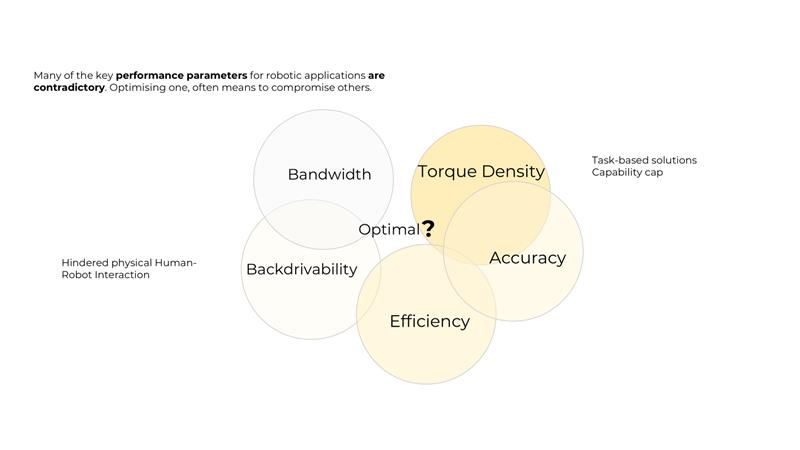
Quasi-Direct Drive (QDD) actuators offer a compelling alternative, enabling high torque output with minimal gear reduction, resulting in superior dynamic performance and enhanced controllability.
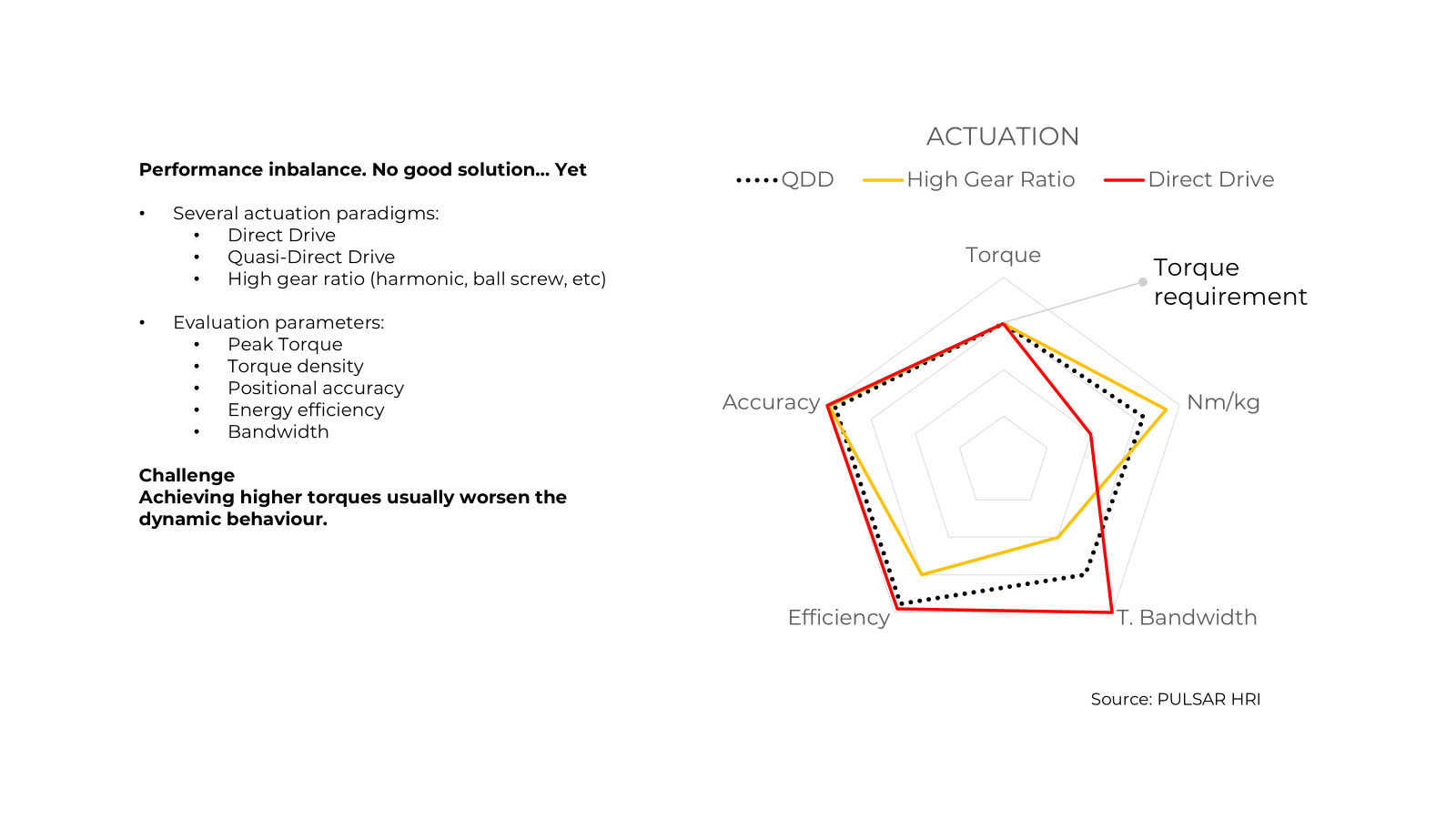
Traditional actuation solutions (high gear ratio) often integrate smaller motors, capitalising on the transmission to produce high torque density at lower power levels. However, the total inertia of the system implies that the motor must always be running, and constantly changing its speed from high positive values to high negative values, which severly impacts the efficiency and thermal dissipation.
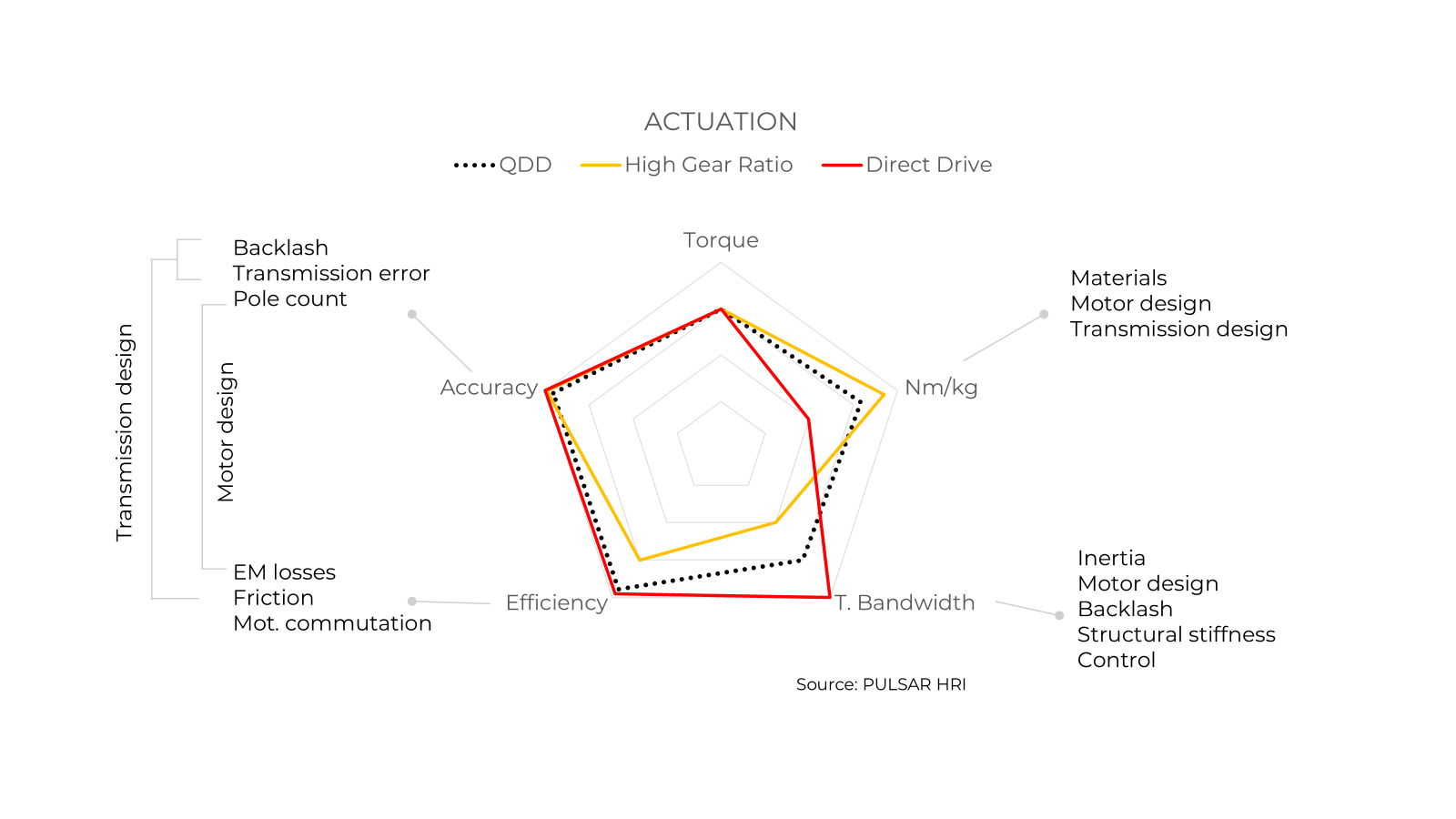
What's a QDD Actuator?
QDD actuators are electromechanical actuators designed with:
- High-torque, low-speed motors (often called torque motors).
- Low gear ratio transmissions (lower than 10:1).
- Integrated electronics and control strategies for torque, speed, and position.
They strike a balance between the direct drive’s responsiveness and the torque amplification of traditional geared actuators—hence the term “quasi-direct.”
Key Benefits of QDD Actuators for Mobile Robots
High Torque Density
QDD actuators can deliver high torque output relative to their mass, although challenging, achieving torque densities comparable to those of high gear ratio transmissions [1]. This performance is made possible by optimizing motor design and minimizing transmission complexity. The result is a lightweight, compact actuator that enables mobile and legged robots to stay agile without compromising on strength — crucial for applications where every Watt and gram counts.
Superior Responsiveness and Bandwidth
Due to the low gear ratio, QDD actuators significantly reduce the inertia of the transmission, preserving most of the native bandwidth of the motor. This results in:
- Faster response.
- Improved disturbance rejection.
- More precise control of impedance and dynamics, which are essential for tasks like walking on uneven terrain, balancing, or interacting with the environment.
Enhanced Safety and Compliance
With high-bandwidth torque control and minimal gear reduction, QDD actuators are inherently safer than traditional actuators. They allow for:
- High-fidelity torque control.
- Dynamic interaction with humans or environments.
- Tunable compliance for better shock absorption and joint protection.
- Transparency and backdrivability for physical interaction.
Energy Efficiency
QDD architectures minimize inertia, internal friction and mechanical losses typically introduced by high-ratio gears. This not only reduces power consumption but also:
- Extends battery life in mobile systems.
- Reduces thermal load, enabling longer duty cycles.
- Increases overall system reliability.
In mobile robots, especially those untethered or operating in remote environments, efficient energy conversion translates directly into longer mission duration and more capable systems.
Reduced Mechanical Complexity
Simpler transmission design means:
- Fewer moving parts.
- Easier and cost-effective manufacturing.
- Simplified maintenance and longer service intervals.
This mechanical simplicity also reduces control challenges associated with gear non-linearities and improves the fidelity of torque control.
Key Drawbacks of QDD Actuators for Mobile Robots
Thermal Management Challenges
Why it matters: Without high gear ratios to amplify torque, the motor must directly produce higher torque, which leads to higher volume and weight or higher current and heat generation, mostly due to the form factor of the motor.
Drawback: QDD actuators are more prone to overheating, especially during continuous high-load operation or in compact, sealed mobile platforms with limited cooling options.
Limited Torque Multiplication (No Gear Boost)
Why it matters: High gear ratios help amplify torque and reduce the current demands on the motor.
Drawback: QDD systems rely almost entirely on the motor itself for torque output, making them less suited for applications with extremely high static or peak torque requirements unless the motor is oversized.
Higher Backdrivability = Lower Passive Holding Torque
Why it matters: Low gearing means the actuator can be backdriven easily (which is great for compliance and safety).
Drawback: In applications that require holding heavy loads without continuous motor effort (e.g., holding a limb position against gravity), QDD actuators may need active torque control or mechanical brakes, increasing complexity or energy use during holding.
Control Stability and Complexity
Why it matters: Low mechanical damping and high responsiveness require fast, precise control loops.
Drawback: Achieving stable control under varying loads, contact dynamics, or at the edge of motor capability requires advanced control strategies and tuning, which increases integration time and system complexity.
QDD Actuators in Mobile Robotics: Pros, Cons and the PULSAR approach
PULSAR HRI approaches QDD actuator design as a tightly integrated system—optimizing every component, especially the motor, to minimize reliance on high gear ratios. Instead of compensating with transmission torque multiplication, we engineer custom high-torque motors from the electromagnetic core outward. This strategy allows us to use low gear ratios (e.g., 5:1) without sacrificing torque, preserving high bandwidth, backdrivability, and energy efficiency. The result is an agile, compact actuator with superior dynamic performance ideal for mobile and legged robots.
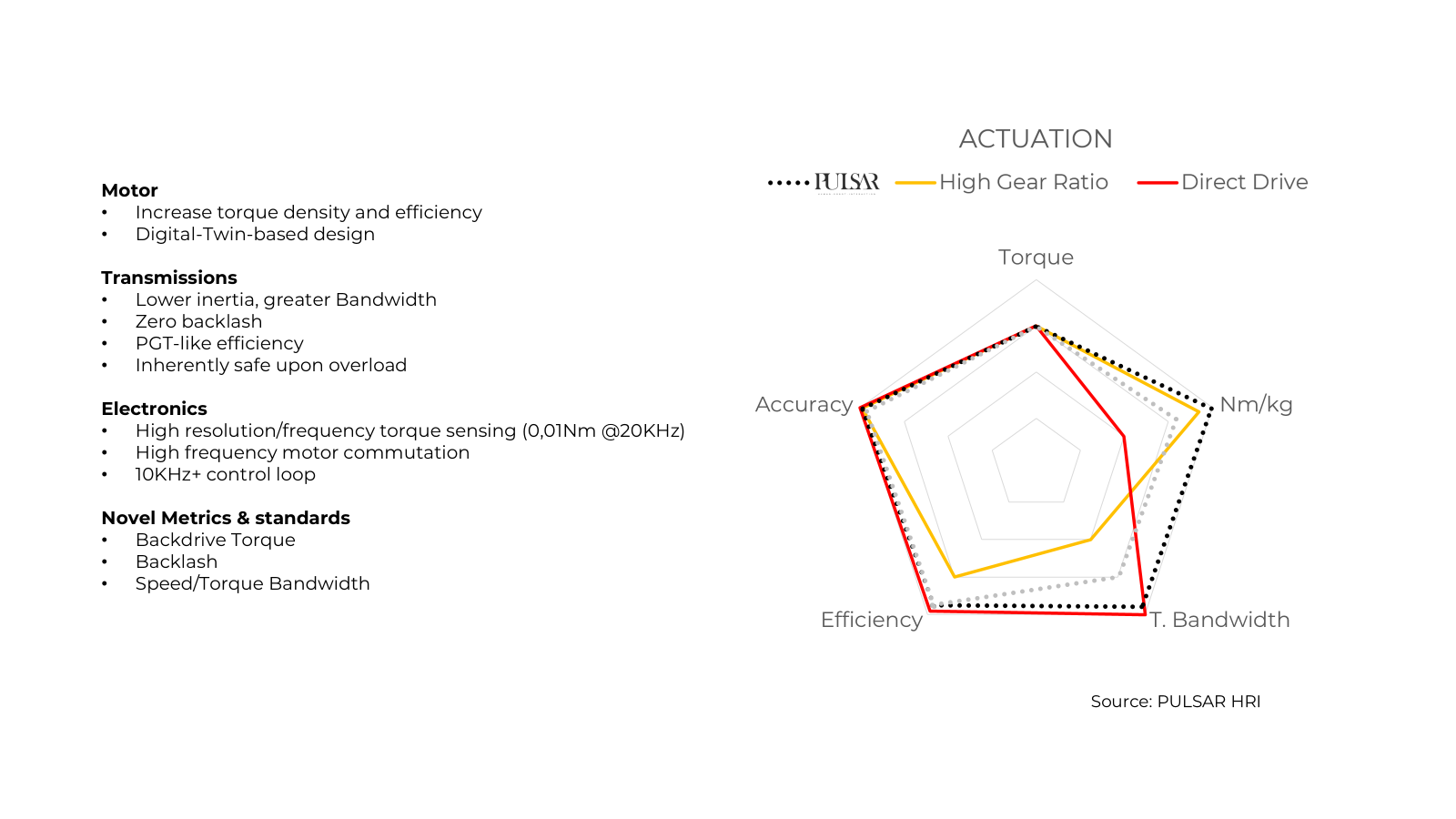
To push the limits of robotic performance, PULSAR HRI emphasizes the need for new, application-relevant metrics and methods — like real torque bandwidth and backdrive torque —. By introducing standardized, replicable measurement methods, we enable fair benchmarking across actuator platforms and help engineers make informed design choices. This shift ensures that actuator performance is not only maximized, but also quantifiable, comparable, and transparent across the robotics industry.
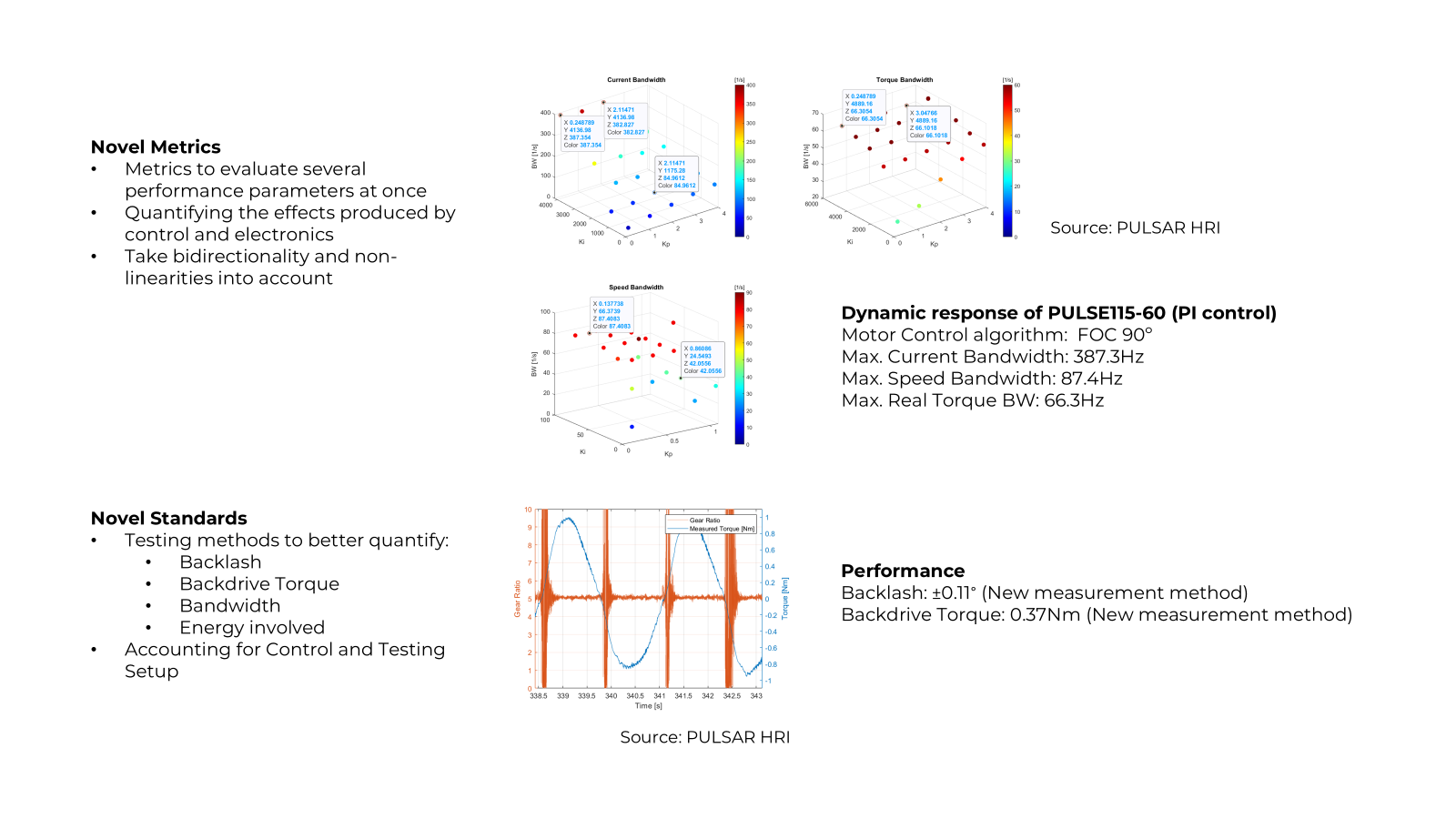
The table below outlines the key challenges in designing and integrating QDD actuators into robotic systems—and how PULSAR HRI is actively addressing each one through a system-level, research-driven approach.
| Challenge | Why It Matters | Drawback | How PULSAR HRI Mitigates This [1] |
|---|---|---|---|
| Thermal Management Challenges | Without gears to reduce load on the motor, it must generate torque directly, causing more heat. | Can overheat under heavy use, especially in small robots with poor airflow. | PULSAR’s motors and actuators are co-designed to maintain torque output with lower current draw. Thermal behavior is modeled using the AUGUR® digital twin, which includes internal losses, current saturation, and temperature evolution. This allows pre-deployment validation of heat build-up under real trajectories, ensuring safety under 25% duty cycle at peak torque without active cooling. |
| Limited Torque Multiplication (No Gear Boost) | Gears help amplify torque so the motor doesn’t have to work as hard. | QDD must generate torque from the motor alone, which limits performance in very high-load tasks. | The PULSE115 includes a custom 5:1 planetary transmission. This balances torque amplification with minimal reflected inertia and low backlash (±0.11°). Unlike traditional high-ratio gears, this low ratio preserves bandwidth and backdrivability while still giving a moderate torque boost. |
| Higher Backdrivability = Lower Passive Holding Torque | Easily backdriven motors are safer and more compliant. | Harder to hold position without constantly applying torque—inefficient for static loads. | PULSE115 achieves 0.37 Nm backdrive torque, verified using a velocity convergence method that accounts for gear friction and backlash. Active holding is handled via dual 20-bit absolute encoders (motor + output) and torque sensor, which enable precise, low-power torque control —even under load— without the need for passive brakes in most scenarios. Additionally, PULSAR motors are designed to hold nominal torque indefinitely without active cooling (up to 45ºC room temperature). |
| Control Stability and Complexity | Fast response is great—but without damping, control can become unstable. | Requires precise gain tuning and robust algorithms, increasing integration effort. | PULSAR’s AUGUR® digital twin includes all actuator internals (gear friction, motor EM dynamics, 10 kHz inner loops, saturation, noise). This allows users to tune control gains in simulation under realistic dynamics. Validated on both 1DOF and 4DOF systems, AUGUR enables <2% sim-to-real error across loads and conditions—greatly reducing integration time. |
Real-World Applications of QDD Actuators
QDD actuators are rapidly becoming a cornerstone in advanced robotic systems:
- Legged Robots (e.g., quadrupeds, small bipeds): Agile locomotion, robust balance, efficient jump and recovery motions.
- Exoskeletons and Wearables: Smooth, responsive motion assistance with safe, low-impedance backdrivability.
- Mobile Manipulators: High precision, low-energy manipulation without compromising on force capability.
Challenges and Considerations
While QDD actuators offer clear advantages, they come with design and integration challenges:
- Motors must be carefully optimized for high torque at low speeds.
- Thermal management becomes crucial, as gear reduction is no longer available to buffer high torques.
- Controllers need to handle low-inertia, high-bandwidth systems — posing a challenge for stability and robustness.
However, with PULSAR motor design method, AUGUR® digital twin for co-simulation (electromagnetic, mechanical, and control), and advanced control electronics, these challenges are increasingly being addressed.
Conclusion
Quasi-Direct Drive (QDD) actuators are critical enablers of agility, efficiency, and responsiveness in mobile and highly dynamic robots. While they offer clear advantages -like low friction and inertia, high bandwidth, and backdrivability- they also present challenges in torque density, thermal management, and control stability. PULSAR HRI addresses these through a full-system design approach, optimizing every component, especially custom high-torque motors, to reduce gear dependence. Their commitment to rigorous research, new performance metrics, and standard benchmarking reflects a determination to set a new standard in actuation for next-generation robotics. Additionally, our AUGUR® digital twin offers a validated virtual environment for accurate simulation, control tuning, and performance prediction -accelerating usability, integration, and trust within the robotics community-.


